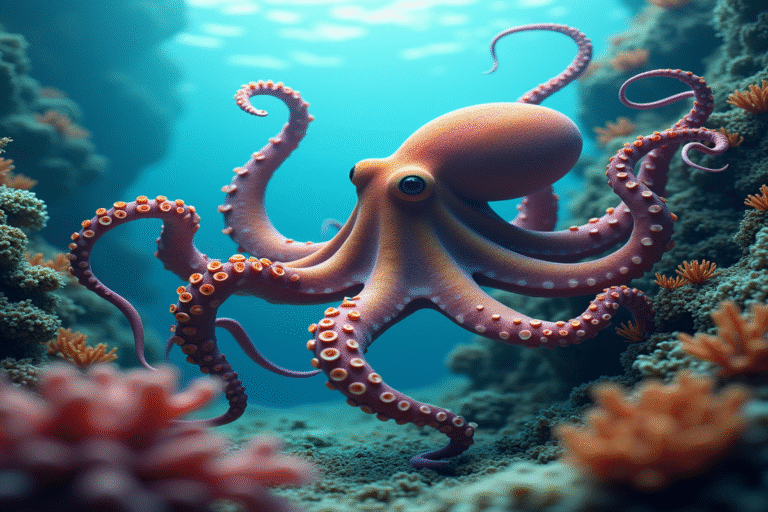Octopuses are among the most intriguing creatures in our oceans—eight-armed wonders that have captivated scientists with their remarkable problem-solving abilities and seemingly alien intelligence. What makes these cephalopods truly extraordinary is that, unlike humans and other mammals, their cognition is not centralized entirely in their brain. Instead, octopuses have a distributed nervous system in which their eight arms can, in a sense, “think” for themselves.
A Brain Unlike Any Other
The central brain of an octopus contains about 180 million neurons, but almost two-thirds of their approximately 500 million neurons are distributed throughout their arms. Each arm contains around 40 million neurons and functions with a high degree of autonomy. In many ways, an octopus is like nine brains working together: one central brain and eight partially independent arms.
Scientists have discovered that each arm can sense, process information, and carry out complex movements independent of the central brain. When an octopus explores a crevice, it does not need to micromanage every movement—the arm itself is able to feel, respond to stimuli, and solve the local puzzle of navigating the space.
Arms with Minds of Their Own
Remarkably, if an octopus’s arm is severed, it continues to respond to stimuli and can even grab food and attempt to pass it toward where the mouth would be. This autonomy is possible because each sucker on an octopus arm contains up to 10,000 neurons, forming a complex network capable of local decision-making.
Research, including studies at the Hebrew University of Jerusalem, has shown that octopus arms maintain functionality even without input from the central nervous system. In experiments, even severed arms would withdraw from unpleasant stimuli or reach toward food, demonstrating their independent processing capabilities.
Problem-Solving Maestros
This distributed intelligence allows octopuses to solve complex problems with startling efficiency. They have been observed using tools, opening childproof pill bottles, navigating mazes, and even escaping from aquariums through tiny openings, contorting their soft bodies through seemingly impossible spaces.
In one famous case at the National Aquarium of New Zealand, an octopus named Inky escaped his tank, crawled across the floor, and squeezed through a narrow drainpipe that led to the ocean. Staff followed a trail of wet marks to the drain, uncovering Inky’s clever escape route.
Multitasking Masters
The decentralized nervous system lets octopuses multitask in ways humans can only imagine. While the central brain may focus on watching for predators, the arms can simultaneously search for food, manipulate objects, and navigate the seafloor.
Jennifer Mather, a cephalopod researcher at the University of Lethbridge, has observed octopuses hunting with several arms probing different crevices at once, each arm independently searching for prey while others anchor the octopus in place.
Learning from Alien Intelligence
This distributed cognition represents a fundamentally different evolutionary strategy compared to our own centralized brain. Octopuses diverged from our evolutionary lineage over 500 million years ago, meaning their intelligence evolved entirely independently from that of vertebrates.
Studying how octopuses process information and solve problems offers insights into alternative forms of intelligence that could inspire advancements in artificial intelligence, robotics, and our understanding of consciousness itself.
When we watch an octopus solving a puzzle, we’re seeing not just the power of a central brain, but a cooperative effort among semi-autonomous arms communicating through complex chemical and electrical networks. It’s a striking reminder that intelligence in the natural world comes in many fascinating forms, often radically different from our own.
Next time you see an octopus in an aquarium, remember: you’re not just looking at one intelligent animal—you’re witnessing nine brains working together in an elegant, tentacled dance of problem-solving brilliance.





